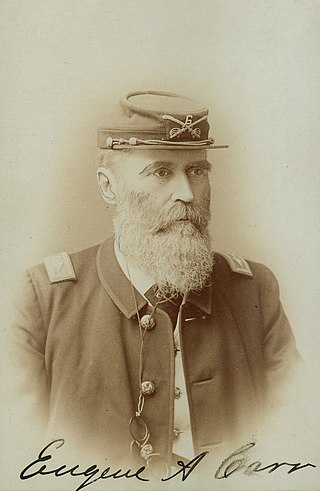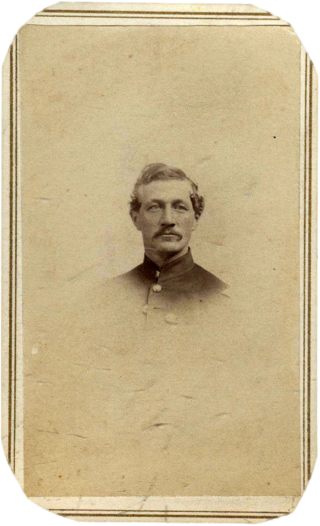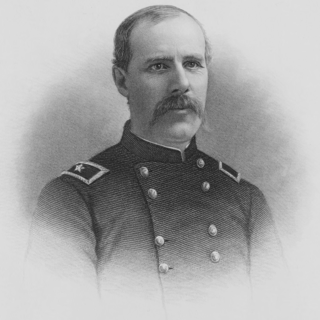
Alfred Thomas Archimedes Torbert was a career United States Army officer, a Union Army General commanding both infantry and cavalry forces in the American Civil War, and a U.S. diplomat.

Wesley Merritt was an American major general who served in the cavalry of the United States Army during the American Civil War, American Indian Wars, and Spanish–American War. Following the latter war, he became the first American Military Governor of the Philippines.

The Appomattox campaign was a series of American Civil War battles fought March 29 – April 9, 1865, in Virginia that concluded with the surrender of Confederate General Robert E. Lee's Army of Northern Virginia to forces of the Union Army under the overall command of Lieutenant General Ulysses S. Grant, marking the effective end of the war.

The Battle of High Bridge refers to two engagements fought on April 6, 1865, and April 7, 1865, near the end of the Appomattox Campaign of the American Civil War about 4 miles (6.4 km) northeast of Farmville, Virginia. The first battle is often the one identified as the Battle of High Bridge.

William W. Wells, Jr. was a businessman, politician, and general in the Union Army during the American Civil War who received a Medal of Honor for gallantry at the Battle of Gettysburg.

Eugene Asa Niel Carr was a soldier in the United States Army and a general in the Union Army during the American Civil War. He was awarded the Medal of Honor for his actions at the Battle of Pea Ridge.

John Irvin Gregg was a career U.S. Army officer. He fought in the Mexican–American War and during the American Civil War as a colonel and near the end of the war as a brevet general in the Union army. In 1866, he was nominated and confirmed as a brevet major general of volunteers and a brevet brigadier general in the Regular Army, both to rank from March 13, 1865.

Eli Long was a general in the Union Army during the American Civil War.

The 5th Michigan Cavalry Regiment was a cavalry regiment that served in the Union Army during the American Civil War. It was a part of the famed Michigan Brigade, commanded for a time by Brigadier General George Armstrong Custer.

Alexander Cummings McWhorter Pennington Jr. was an artillery officer and brigadier general in the United States Army and a veteran of both the American Civil War and Spanish–American War.

Henry Eugene Davies was an American soldier, writer, public official and lawyer. He served in the Union Army as a brigadier general of volunteers in cavalry service during the American Civil War and was promoted to the grade of major general of volunteers at the end of the war. Davies was one of the few nonprofessional soldiers in the Union cavalry in the East to be promoted to the grade of general. He led his brigade in several major battles, especially during the Overland Campaign, the Battle of Trevilian Station, the Siege of Petersburg and the Appomattox Campaign at the end of the war.

Richard Woodhouse Johnson was an officer in the Union Army during the American Civil War.

Thomas Worcester Hyde was an American Union Army colonel, a state senator from Maine, and the founder of the Bath Iron Works, one of the major shipyards in the United States. He wrote two books about his experiences during the American Civil War and at the Battle of Gettysburg.

Charles Henry Tompkins was an American officer who served as a Union Army colonel, who received an appointment to the brevet grade of Brigadier General of volunteers during the American Civil War. He was a recipient of the Medal of Honor for valor in action on June 1, 1861, in the Battle of Fairfax Court House. This was the first action in the Civil War for which a Union Army officer would receive the Medal of Honor, although it was not awarded until 1893. He is not to be confused with another Union officer, Brevet Brigadier General Charles H. Tompkins who commanded the 1st Rhode Island Light Artillery Regiment.

James Adams Cunningham was a volunteer officer in the Union Army during the American Civil War.

Edward Francis Winslow was an American soldier, railroad executive, and merchant who served as colonel and brigadier general of the 4th Iowa Cavalry Regiment during the American Civil War from 1864 to 1865. Winslow participated in numerous Union Army campaigns of the Army of the Tennessee, including the Siege of Vicksburg.
Ulysses Doubleday was a Union Army colonel during the American Civil War. In 1866 he was nominated and confirmed for appointment to the grade of brevet brigadier general of volunteers, to rank from March 13, 1865.
Benjamin Franklin Gordon, commonly known as B. Frank Gordon, was a Confederate States Army colonel during the American Civil War. Gordon had been a private and bugler for a Missouri regiment serving in the U.S. Army during the Mexican–American War. Gordon served in the Confederate Army under Brigadier General Joseph O. "Jo" Shelby in Missouri and Arkansas in the Confederate Trans-Mississippi Department throughout the war. On May 16, 1865, with the war coming to an end, General E. Kirby Smith, as the Confederate commander of the Trans-Mississippi Department, assigned Gordon to duty as a brigadier general. The Confederate government took no action on the appointment and Confederate President Jefferson Davis did not officially appoint and nominate Gordon to the rank of brigadier general because the Confederate Senate last met on March 18, 1865, and Davis was captured by Union troops on May 10, 1865. Although he was only aged 40 at his death, Gordon survived the war by little more than a year.

Daniel Henry Rucker was a career officer in the United States Army. He was commissioned in 1837 and served for nearly 45 years, including during the American Indian Wars, Mexican–American War, and American Civil War. He attained the rank of brigadier general and was most notable for his service as Assistant Quartermaster General of the United States Army, then Quartermaster General. Rucker received brevet promotions to major general of United States Volunteers and major general in the Regular Army in commendation of his Civil War service. Rucker was the father-in-law of General Philip Sheridan.

Joab Nelson Patterson (1835–1923) was an American brevet brigadier general and politician who commanded the 2nd New Hampshire Infantry Regiment across several battles of the American Civil War, as well as the commander of the Third Brigade of the First Division of the XVIII Corps. He also held several offices after the war as well as a captain during the Spanish–American War.


















